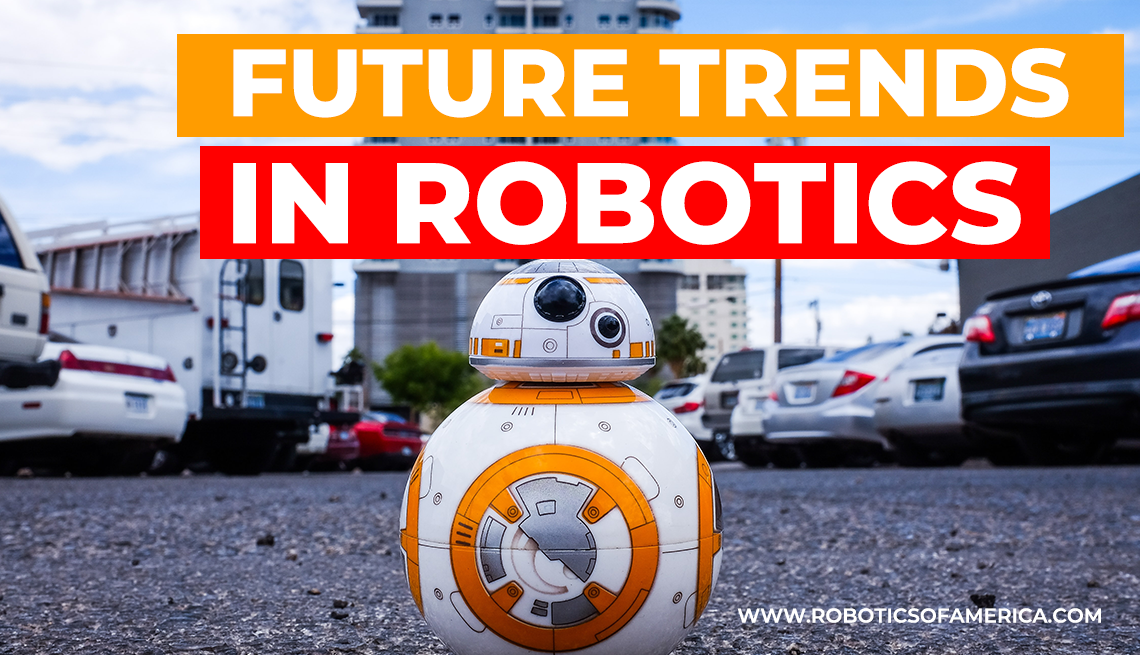
Future Trends in Robotics
7 Future Trends in Robotics
Analysts are making many bold predictions about future trends in robotics. Sure, a lot of the predictions seems like they are light-years away from reality. But most are not. And that is due to the almost limitless capacity of robotic technology. This technology continues to evolve at record paces every year.
Think to yourself about all the robotic changes you have seen over time. Twenty years ago, you wouldn’t witness many robots in factories. But thanks to technology developments, there are now tons of robots within them. And that’s the case all over the globe. What makes robotics so popular for companies?
The ultimate ability to boost profits and ROI. This is why you and your team should read up on the future trends of robotics. Are you ready? Let’s get started.
The Top 7 Future Trends in Robotics That Will Influence Many Industries
Future trends in robotics will influence almost every industry in the world. Many people assume that robotic technology only applies to manufacture. Sure, it does. But robotics can make operations easier for all types of organizations. In fact, that’s already happening now. But this article isn’t about right now. It’s about the future. Below are seven potential future trends in robotics.
Future Trend in Robotics #1: IIoT
IIoT is a future trend in robotics that will influence many industries. What is IIoT? It stands for the Industrial Internet of Things. And that is what many robots are going to connect to in the coming years.
More and more robots are going to use smart sensors. When will they do so? Towards the end of production to collect data. This is important information that many manufacturers used to not be able to access. But times are changing fast. The IIoT is continuing to expand every day. So, what is going to be the final outcome? Better levels of efficiency for all job sectors.
Future Trend in Robotics #2: Industrial Cybersecurity
This is a future trend in robotics that is already manifesting right now. More and more companies are realizing that industrial cybersecurity matters. That’s why they are making it a priority to boost capabilities. Think to yourself how robots are more connected to internal systems than ever before. The more these machines collect data, the more potential risks come into play. And what are the most important risks? Ones that involve cybersecurity. This means that companies will have no choice but to take care of vulnerabilities. And they need to do so before those vulnerabilities lead to damages.
Every technology process carries a different level of vulnerability. It’s up to your company to assess what those vulnerabilities are. And also how to prevent them from occurring. Robots are going to make prevention methods a lot easier for organizations. But your company will have to invest in cybersecurity technology in the future.
Future Trend in Robotics #3: Big Data Analysis
Big data analysis is a major future trend in robotics. This is an agreed-upon notion by many industry experts. In fact, big data analysis is going to end up being a key competitive driver. Think of how robots already affect the modern factory floor. They serve as a go-to source for relevant information in each factory. But organizations cannot assume that their data collections are stable.
Companies are going to need new systems that organize huge collections of data. And organization is only half of the equation. Robotic technology will allow big data collections to get analyzed. Otherwise, how will companies know what to do with their data? Current processes that take weeks to analyze data will soon take hours. And it’s all thanks to developments in robotics.
Future Trend in Robotics #4: Open Automation Architectures
Many future trends in robotics, of course, involve developments in automation. That’s because robotic automation is getting adopted by more and more organizations. This creates a need for open automation architectures to advance.
Many noteworthy industry experts are soon going to assist robotics firms. What will their mission be? To create open documentation and standards for robot integration. And here’s some great news. This can happen without products becoming less compatible. In fact, open automation architectures will make them more compatible.
Future Trend in Robotics #5: Virtual Solutions
Here’s a future trend in robotics that every company in the world can get behind. After all, who doesn’t want to experience solutions to virtual problems? But many current virtual solutions focus on software. But in the future, solutions will allow physical processes to experience big boosts. Industrial robotics applications are going to improve once there are more virtual solutions.
Let’s use a current application as an example. It’s an application that is growing in popularity. It's known as "virtual representation" for robotics applications. That representation can take care of many issues. What are two of the most common issues that it affects? Offline programming and proof of concepts. Expect both processes to improve once there are more advanced virtual solutions.
Future Trend in Robotics #6: Collaborative Robots
Analysts always reference certain robots when discussing future trends in robotics. What is one one of the most common forms of robots that they bring up? Collaborative robots. Sure, they already exist at this moment. But expect their popularity to skyrocket in the coming years. Why should we expect this to happen? Because they can work with humans in a safe manner. Plus, their cheap price-point is a major advantage. Other forms of industrial robots are a lot more expensive than collaborative bots.
Robotics experts are testing out new versions of these amazing machines right now. What is the basis of the testing? It concerns if the robots can handle difficult industrial settings. Once they can, companies all over the world will start purchasing them. What will this lead to? Companies with tight ROI requirements will have access to robots.
Collaborative robots have a reputation for adapting to any sort of environment. This will take the pressure off humans (in hundreds of jobs) to do all the work. Expect applications for these bots to expand year-after-year. This shouldn’t come as a shock. After all, many shared workspace applications already involve robots. But the robots of the future will be much more efficient and intelligent.
The key focus is on getting the robots to respond to questions and commands in real-time. Once the capability is there, collaborative robots will be a total game-changer. Words are not the only thing that the robots will be able to interpret. They’ll have the ability to recognize a person’s speech patterns and gestures.
They will also have the capacity to infer how a person feels based on his or her tone of voice. Next thing you know, a company will reach its financial goals a lot faster than before.
Future Trend in Robotics #7: Digital-Based Robots
This future trend in robotics might not surprise you as much as some of the others. After all, aren’t all robots digital? Well, yes and no. Most use digital programs. But they themselves are not 100% digital. But this is soon going to change. The modern industrial robot uses both networks and digital production mechanisms. These production mechanisms get recognized as the “industry 4.0.”
4.0 robotic applications ensure that robot systems can communicate with one another. The technology exists for systems that stem from separate manufacturers to communicate. But that technology is still getting perfected inside robotic research centers. In the future, robotic communication will be way more complex than it is right now. But don't panic about this. It will be easy for humans to track communication.
Robotics experts are developing standardized generic interfaces for industrial robots. These experts include people from the VDMA and OPC Foundation. (OPC stands for Open Platform Communications.) What do these interfaces do? They allow each robot to plug in to the IIoT. Again, this is the Industrial Internet of Things. That process leads to robots becoming 100% digital-based.
Once this happens, companies are going to reap tons of new benefits. Imagine what your organization can do with business models fueled by cloud technology. This is only one example of how digital-based improvements can affect companies.
Here is another example. You're going to begin to see robot leasing companies emerge into the mainstream. A lot of these companies will be small and medium-sized. These businesses will use a robots-as-a-service business and technology model. A model like this carries many advantages that will give business owners tons of ROI. Companies will lease robots to consumers without the involvement of committed capital.
Plus, there will not be a need for automatic upgrades and fixed costs. In fact, there won’t even be a need for high-skilled robot operators. Instead, the digital-based robots will be intelligent enough to maintain controls without help.
Conclusion: The Future Trends in Robotics Will Benefit Many Companies
The sky is the limit when it comes to future trends in robotics. It makes no difference at all what industry your company’s involved with. Developments in robotics should improve many aspects of your business operations. The key is to get involved in robotics right now, while the technology is still developing.
This will prevent you from losing ground to your competitors. If you would like to learn more about how robotics can benefit your company, contact our firm today. We assist companies across all industries. Our mission is to boost our clients’ profits and ROI through robotic applications. Also, check out our website for related articles on topics such as:
- -robotic trends 2021
- -future of industrial robots
- -advances in robotics
- -current trends in robotics
- -future technology in robotics
- -future application of robotics

